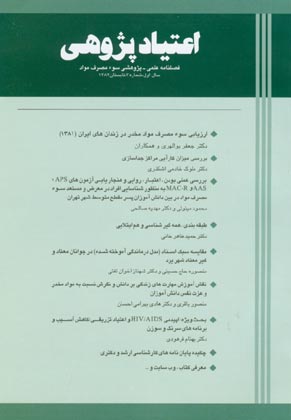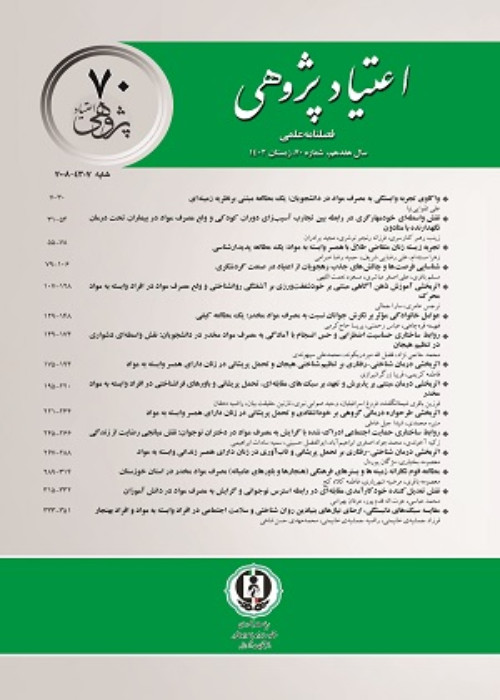فهرست مطالب

فصلنامه اعتیاد پژوهی
پیاپی 3 (تابستان 1382)
- 226 صفحه،
- تاریخ انتشار: 1382/05/15
- تعداد عناوین: 11
-
صفحه 11
-
صفحه 13مواد مخدر در همه زندان های دنیا مصرف می شود؛ به طوری که دولت ها را به چالش و مبارزه با این پدیده خطرناک فرامی خواند. پژوهش حاضر در پی تعیین مزان شیوع سوء مصرف مواد مخدر در بین زندانیان در زندان های کشور است. به علاوه، تفکیک ویژگی های دموگرافیک مصرف کنندگان، تعیین توزیع نوع مواد و روش مصرف در زندانیانن، بررسی وجود رفتارهای پر خطر و میزان آن در بین زندانیان و بررسی شیوع اختلالات روانی همراه با سوء مصرف مواد مخدر از اهداف دیگر این پژوهش است. این پژوهش به صورت مطالعه کمی و کیفی و به روش مقطعی انجام گرفته است.کلیدواژگان: سوء مصرف مواد مخدر، اعتیاد، مواد مصرفی، رفتارهای پر خطر، اختلالات روانی
-
صفحه 51اعتیاد به مواد مخدر یکی از معضلات اجتماعی است که عوارض آن به فرد معتاد محدود نمی شود؛ بلکه، آن عوارض به خانواده و جامعه نیز سرایت می کند و خسارات جبران ناپذیری را بر جای می گذارد. دامنه این عوارض گاه به انواع جرائم، همچون سوء استفاده از کودکان در خانواده تسری می یابد؛ خانواده برای این گروه بی دفاع به جای آن که محل امن و آرامی باشد، به محلی برای آموزش خلافکاری، اعتیاد و انواع ناهنجاری های رفتاری تبدیلی می شود. ایجاد خوابگاه های طرح جداسازی دانش آموزان از والدین معتاد فاقد صلاحیت در چارچوب توجه به این گروه از کودکان و مشکلات آنان است.کلیدواژگان: مراکز جداسازی، والدین فاقد صلاحیت، اعتیاد و دانش آموز
-
صفحه 77رشد روز افزون مواد مخدر در جامعه و استفاده از ابزارهای مناسب برای تشخیص افرادی که سوء مصرف مواد دارند یا در معرض خطر سوء مصرف آن هستند، از نیازهای اساسی جامعه کنونی ایران به شمار می رود. هم اکنون تنها روش شناسایی افراد معتاد، استفاده از کیت های تشخیص مرفین در ادارا است که بر مدل پزشکی مبتنی است و فقط وجود مرفین را در ادرار نشان می دهد و نمی توند روش مطمئنی برای شناسایی فرد معتاد باشد. در این چارچوب، به نظر می رسد که استفاده از آزمون های روان شناختی برای شناسایی افراد در معرض خطر سوء مصرف مواد و تشخیص اعتیاد ضروری باشد.کلیدواژگان: هنجاریابی، سو ء مصرف مواد، آزمون سنجش اعتیاد
-
صفحه 109در حالی که راهنمای تشخیصی و آماری اختلالات روانی (DSM) انجمن روانپزشکی امریکا طی 28 سال یعنی از سال های 1952 تا 1980 تنها دو بار تجدید نظر شده بود، در عرض نصف مدت فوق یعنی 14 سال دوبار دیگر نیز تجدید نظر شد. یعنی، (تدوین DSM - III - R در سال 1987 و DSM در 1994). در همین زمان، برای طبقه بندی بین المللی بیماری ها (ICD) که در خارج از آمریکای شمالی مورد استفاده قرار می گیرد نیز تعدیل شد. اختلالات اعتیاد یا به عبارتی اختلالات وابستگی یا سوء مصرف موار روانگردان نیز برای ارایه دلایل و نتایج بهتر از این تغییر مصون نماند.کلیدواژگان: اختلالات اعتیاد، طبقه بندی DSM و ICD، همه گیر شناسی
-
صفحه 133هدف از انجام تحقیق حاضر، بررسی تاثیر سبک اسناد بر میزان گرایش و ابتلای جوانان بر اعتیاد بوده است. برای دستیابی به این هدف، فرض شده جوانان معتاد سبک تبیین بدبینانه تری نسبت به جوانان غیر معتاد دارند؛ یعنی، درماندگی آموخته شده در جوانان معتاد بیشتر از جوانان غیر معتاد است و بر اساس ابعاد شش گانه سبک اسناد، شش فرض فرعی تدوین شد. جامعه آماری این پژوهش شامل کلیه جوانان 18 تا 28 ساله ساکن در شهر یزد (در قالب دو گروه معتاد و غیر معتاد) بود که برای انتخاب نمونه معتاد از روش سرشماری، و برای انتخاب نمونه غیر معتاد از روش تصادفی استفاد شد.کلیدواژگان: اعتیاد، سبک اسناد، درماندگی آموخته شده
-
صفحه 149هدف از پژوهش حاضر، بررسی اثرات آموزش مهارت های زندگی بر دانش و نگرش نسبت به مواد مخدر و عزت نفس دانش آموزان بود. طرح پژوهش از جمله طرح های آزمایشی و مجموعه طرح های پیش آزمون - پس آزمون با گروه کنترل است. حجم گروه های نمونه 60 پسر دانش آموز (30 نفر گروه آزمایش و 30 نفر گروه کنترل) بود. یافته های پژوهش حاضر عبارتند از: 1- آموزش مهارت های زندگی به دانش آموزان موجب ایجاد تغییرات معنی ادار (در سطح 001/0›P) در دانش آموزان نسبت به مواد مخدر شده است.کلیدواژگان: مهارت های زندگی، دانش، نگرش، عزت نفس و مواد مخدر
-
صفحه 201
-
Page 13Drugs are consumed in all prisons throughout the world in such a way that the matter has turned into a challenging issue for the governments. The current research seeks to determine the level of the spread of drug abuse among prison inmates in the country’s prisons. To name the other objectives pursued by this research one can refer to the distinction of demographic features of the abusers, determining the type of drugs distributed, the method of consumption in prisons, existence of high-risk behaviors and its level among prison inmates as well as taking into consideration the spread of mental disorders along with drug abuse. Such a research has been carried out in the form of a qualitative and quantitative study. The collection of the required data in the qualitative study was conducted by using detailed questionnaires and through interviews in four groups comprising male and female inmates who have committed drug-related crimes or other offences, prison wards as well as prison authorities. In the quantitative study that was conducted on male inmates questionnaires related to demographic and general specifications, the assessment of the situation of drug abuse and individuals’ view towards drug abuse as well as SCL-90-R were used. The group under study includes all prison inmates, prison wards and prison authorities in Iran. The individuals under study were selected from prisons in five different provinces using the cluster sample-taking and random methods. The number of individuals in the sample reached 1436 people. In order to clarify the outcome, frequency tables, mode, mediam, mean, standard deviation as well as X & Z tests were used. The result of the research implies that the comparison of drug abuse before and after entering the prison indicates a meaningful relationship.Meanwhile no meaningful difference was observed among age groups.
-
Page 51Addiction to drugs is one of the social problems the negative consequences of which are not merely limited to the addicted person. On the other hand, such negative consequences will also overshadow the person’s family and society and inflicts irreparable damage on them. Such consequences may in some cases lead to the perpetration of crimes such as child abuse in the family. In this way the family will no longer remain as a safe place for the child and the child will start doing misdeeds, become addicted and end up as a person who suffers from behavioral abnormalities. The setting up of separation dorms is within the framework of taking into account the problems related to these children. The current research has made an assessment of the efficiency of the said centers after the launching of their activities. The basic goal pursued by the research is to see whether the goals set for the separation plan have been materialized and to see whether those participating in the plan were admitted or discharged based on relevant sets of rules. There is full supervision over the implementation of the plan and the second part goes to surveying the level of individuals’ satisfaction over the plan. Moreover, the level of contribution by membering organizations in the implemen- tation of the plan and the rate of its success and solutions for the improvement of the plan were taken into account. The method of research applied is based on documented evidence and surveys.
-
Page 77Bearing in mind the growing trend of drug abuse in societies, the application of appropriate tools for identifying drug abusers and those who are exposed to the high risk of drug abuse is one of the basic requirements of the current Iranian society. At the moment, the only way for identifying drug addicts is the use of morphine- detecting kits that examine the person’s urine and is based on a medical model. It only indicates the existence of morphine in urine and cannot be relied upon as a certain method for detecting the person’s addiction. Within this framework, it seems necessary to use psychological tests for identifying individuals that are exposed to the risk of drug abuse. Based on this necessity and with the aim of normalization and preparation of three sub-scales of addiction acknowledgement scale (AAS), addiction potential (APS) and Mac Andrew Alcoholism Scale Revised (MAC.R) from the Minnesota Multi-Phasic Personality Inventory a questionnaire is prepared comprising 90 questions. The plan was conducted among 1000 male high school students of Tehran using the random sample-taking from 4 districts (7,5,3,18) as well as 200 volunteers who seek to give up addiction. The following questions were raised:1. Does the addiction test for identifying students exposed to addiction risk enjoy reliability?
-
Page 109Revised only twice in the 28 – year period from 1952 to 1980, the American Psychiatric Association`s Diagnostic and Statistical Manual of Mental Disorders (DSM) has been amended two more times in half as many years, with the publication of DSM – III – R in 1987 and of DSM – IV in 1994. The DSM counterpart in use outside of North America, the International Classification of Diseases (ICD), also underwent modification during this time period. Requirements for the addictive disorders, or as termed here, psychoactive dependence or abuse disorders, were not immune to change for good reason and to a good end. Unlike other psychiatric disorders, for which ICD and DSM criteria often were the same, a schism existed between the DSM and ICD criteria for addictive disorders.ICD criteria were shaped by an influential article that introduced the construct of a dependence syndrome, but this conceptualization was not operationalized in the DSM system until the publication of DSM – IV. With this latest revision, criteria for substance dependence now closely matches those in the ICD – 10 system, establishing for the first time what may be considered a worldwide classification system for addictive disorders.Keywords: Addictive Disorders, Classification of the DSM, ICD, Epidemiology, Comorbidity
-
Page 133The aim of this research is to look into the impacts of Attributional theory over the rate of youths’ tendency towards addiction. In order to reach this goal, it has been assumed that learned helplessness is far more among addicted youths compared to non-addict youths. On the basis of the six dimensions of Attributional theory six subsidiary assumptions were formulated. The statistical grouping under study included all the youths from the age of 18 to 28 residing in Yazd (within the framework of two addicted and non-addict groups). The census method was used for selecting the addicted sample and the random method was applied for selecting the non-addict sample. Eventually 97 addicts and 10 non-addicts were selected. The Attributional theory questionnaire was used for collecting data. It was later analyzed using the statistical T test. It was finally indicated that addicted youths are more suffering from learned helplessness compared to non-addict youths.Keywords: Addiction, Attributional Theory, Learned Helplessness
-
Page 149The research seeks to examine the role of life skills concerning attitude towards narcotic drugs and students’ self-esteem. The research design is experimental and includes pilot plans as well as pre-test and post-test control group designs. The sample groups include 60 male students (30 students in the pilot group an 30 students in the control group). The research results are as follows:1.Offering life skills’ training to students has caused meaningful variations (P-0.001level) in students’ knowledge towards the issue of drugs.2.Offering life skills’ training to students has caused meaningful variations (P-0.001level) in students’ attitude towards drugs3.Offering life skills’ training to students has caused meaningful variations (P-0.001level) in students’ self-esteemKeywords: Life Skills, Knowledge, Attitude, Self, Esteem, Narcotic Drugs


